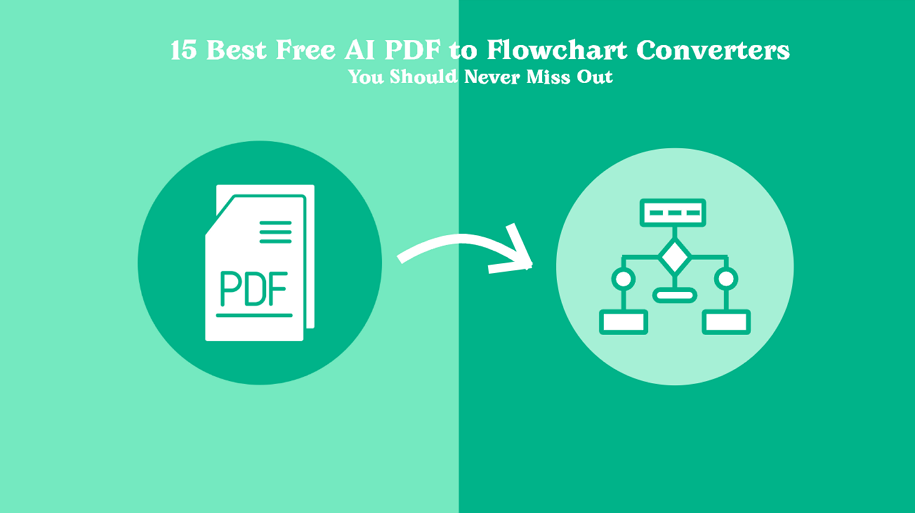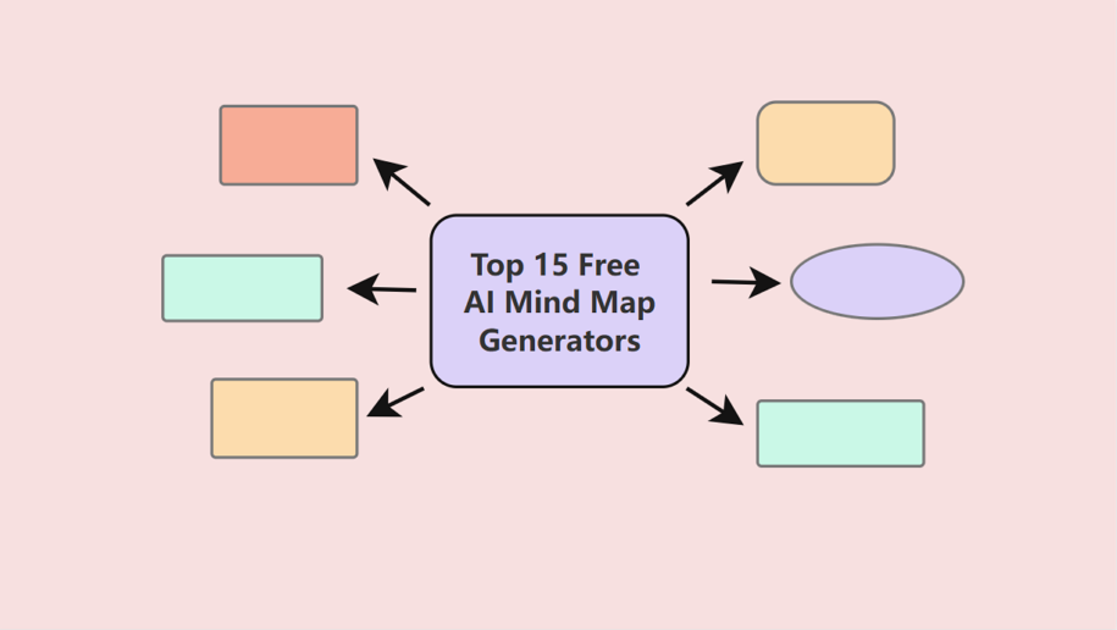
Miro has long been a popular choice among agile teams for seamless online collaboration. But as team needs evolve—especially with the growing role of AI in workflows—Miro might not be the perfect fit for everyone, particularly those with more advanced or unique requirements.
If you’re searching for a smarter, AI-powered alternative to Miro, you’re in the right place. Our team has thoroughly tested and curated 15 of the best free and paid Miro alternatives to help solve your collaboration challenges and dramatically boost your team’s productivity.
Plus, our own free AI whiteboard and diagramming tool can help you and your team get more done—not in hours or days, but in moments.
What is Miro? What makes it stand out?
Miro is a popular online collaborative whiteboard platform designed for teams to brainstorm, plan, and work together in real time—no matter where they are. It offers an infinite canvas where users can add sticky notes, diagrams, flowcharts, wireframes, and more, making it ideal for creative thinking and agile workflows.
What Makes Miro Stand Out?
Miro stands out for several key reasons:
- Real-time Collaboration: Teams can work together simultaneously, leave comments, and run interactive workshops or meetings with ease.
- Intuitive Interface: Its drag-and-drop functionality and user-friendly design make it accessible for users of all technical levels.
- Wide Range of Templates: Miro provides hundreds of pre-built templates for brainstorming, agile planning, UX research, mind mapping, and more.
- App Integrations: It connects seamlessly with tools like Slack, Jira, Zoom, Microsoft Teams, Notion, and Google Drive—making it easy to fit into any workflow.
- Versatile Use Cases: From product roadmapping and sprint planning to education and strategy sessions, Miro adapts to a variety of team needs.
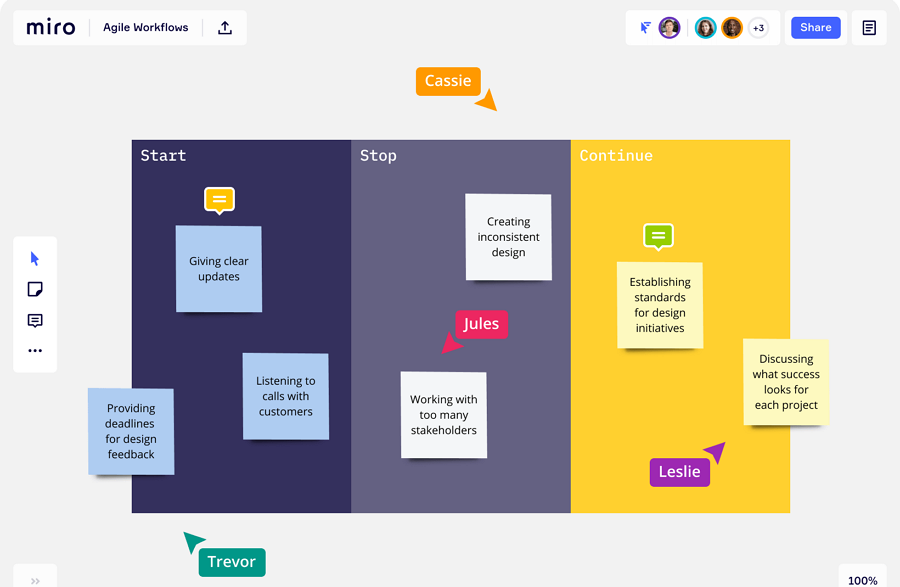
Despite its popularity, Miro may not be ideal for every team—especially those seeking more advanced AI features, specialized workflows, or a budget-friendly solution. That’s where the alternatives come in.
Why people are looking for Miro alternatives
While Miro is a powerful and widely used collaboration tool, it’s not a perfect fit for everyone. Here are a few common reasons why teams and individuals start looking for alternatives:
- Limited Free Plan: Miro’s free version comes with restrictions on the number of editable boards and advanced features, which can be limiting for growing teams.
- Pricing: For startups, small teams, or individual users, Miro’s paid plans can be expensive—especially when scaling across a larger organization.
- Performance Issues on Large Boards: As boards become more complex, some users report lagging or performance drops.
- Missing AI Capabilities: In an era where AI boosts productivity, Miro lacks deeper native AI integration for tasks like auto-generating diagrams, summarizing ideas, or smart formatting.
- Overwhelming for Simple Use Cases: For teams that need just basic brainstorming or quick diagramming, Miro can feel overly complex or feature-heavy.
- Privacy or Self-hosting Needs: Some teams—especially in enterprise or regulated industries—prefer tools with stronger data control or self-hosting options, which Miro doesn't offer.
Whether it’s about pricing, performance, or specific features, these gaps are pushing more teams to explore tools that better fit their unique needs.
Top 15 Miro Alternatives to level up your work efficiency
1.Fluig
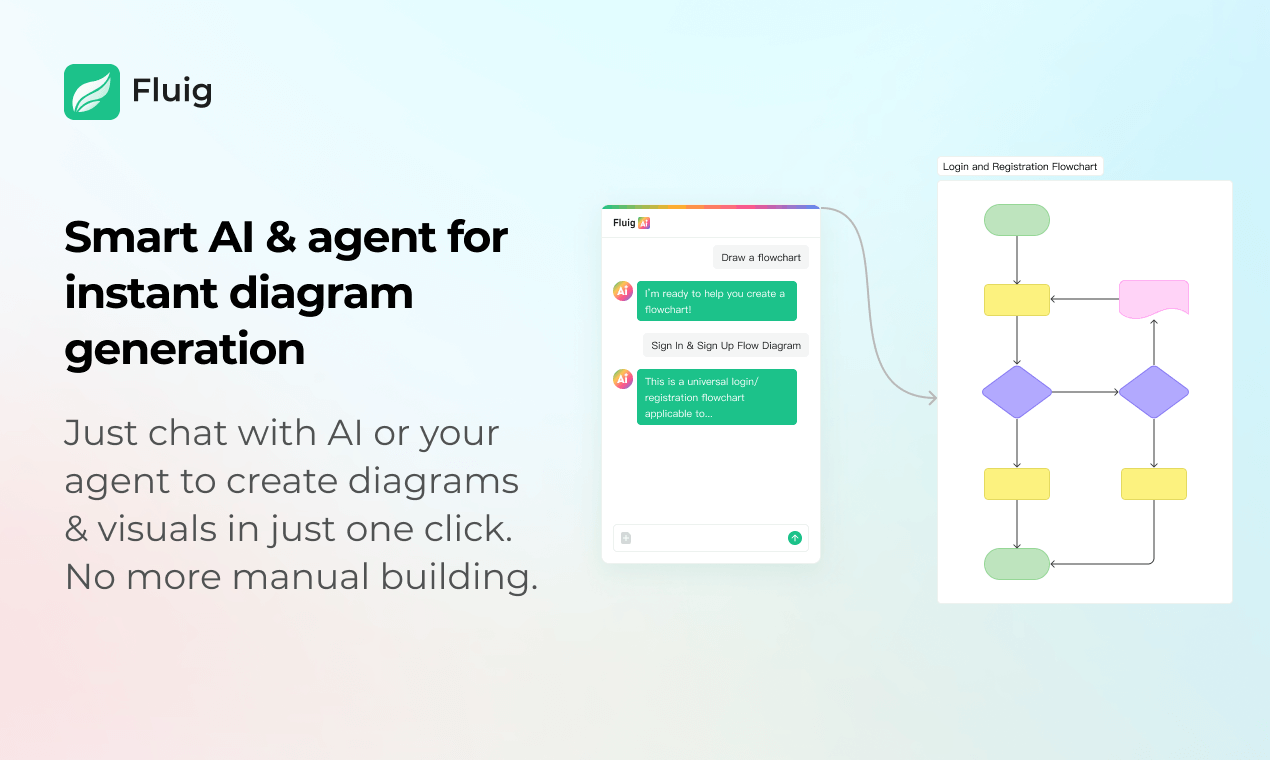
Fluig is a next-gen AI-native whiteboard and diagramming tool designed to supercharge how teams brainstorm, plan, and collaborate.
Unlike traditional tools, Fluig uses AI to help you automatically analyze uploaded files, generate editable mind maps or flowcharts, and even convert between chart types.
Simply drop your ideas or files into the AI chat panel, and your desired diagrams, like mind maps, flowcharts, tables, cards, fishbones, and similar visuals, would show up in just a flash.
With real-time collaboration and interactive sharing capabilities, Fluig is perfect for fast-moving teams who want both visual thinking and intelligent assistance in one place. It’s built for creators, strategists, and teams who need to work smarter—not just harder.
Key Features:
- AI-powered chart generation from files, images, website url, and descriptions
- Real-time whiteboard collaboration with teammates
- Instant conversion between mind maps, flowcharts, etc.
- Shareable interactive diagrams for feedback and insights
- Demonstrate ideas with live slideshow
Pros:
- Unique AI-driven experience for faster output
- Lightweight, fast, and modern interface
- Rich input and output options
- Easy exports and share
- Great for both individual use and cross-functional teams
Cons:
- Still evolving compared to long-established tools
- Limited third-party integrations (currently being expanded)
Pricing:
Free plan available; Premium plans start at $1 with 15-days and unlimited AI access
Best For:
Teams looking for an intelligent, AI-native whiteboard to brainstorm and plan visually in a short time
2.Lucidspark
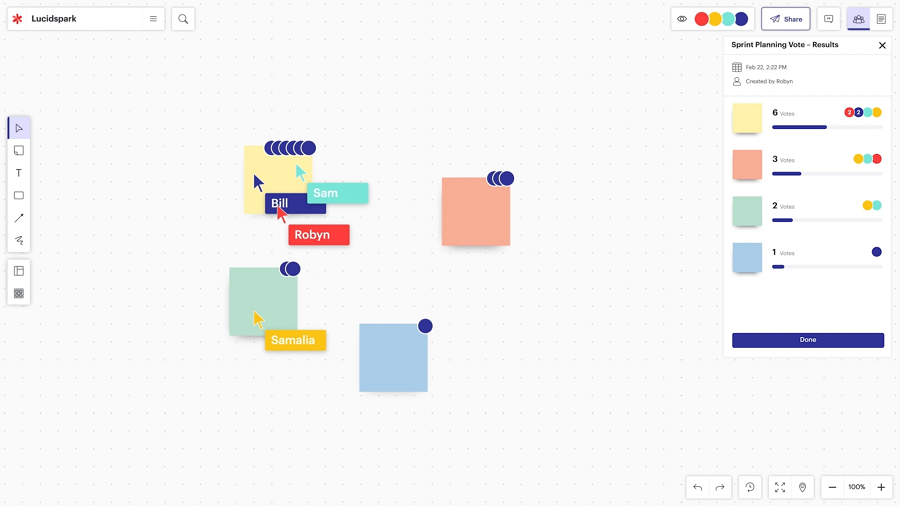
Lucidspark is a robust online whiteboard developed by the creators of Lucidchart, designed to support ideation, planning, and collaboration across distributed teams.
It offers real-time tools like voting, chat, and breakout areas that make meetings more interactive and outcomes more actionable. Seamlessly integrated with Lucidchart and major productivity tools, it lets you turn rough ideas into refined workflows in just a few clicks.
Lucidspark is ideal for agile teams who value structure and momentum during the brainstorming phase.
Key Features:
- Sticky notes, freehand drawing, and visual containers
- Voting, timers, and breakout sessions for workshops
- Integrations with Lucidchart, Slack, Zoom, Jira, and more
- Team cursors for real-time participation
Pros:
- Well-balanced between structure and flexibility
- Strong integration with other work tools
- Smooth transition from brainstorming to documentation
Cons:
- Some limitations on the free plan
- May feel too formal for very casual or visual-first users
Pricing:
Free plan available; paid plans start at $9 per user
Best For:
Teams that want structured brainstorming sessions with built-in tools for agile and project workflows
3.FigJam
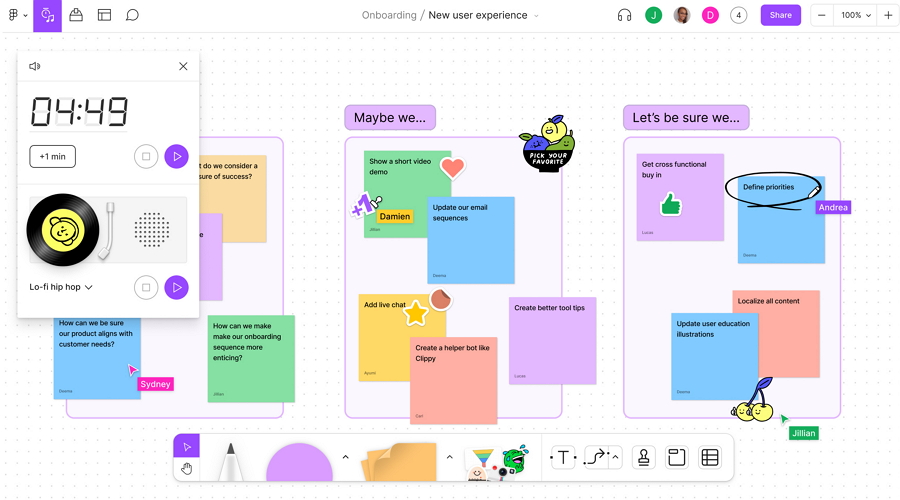
FigJam, developed by Figma, is a highly collaborative whiteboard tool designed for designers and product teams to ideate and communicate visually.
It features a fun, casual interface with sticky notes, emojis, stamps, and cursors that encourage creative flow. FigJam stands out with seamless integration with Figma, making it easy for design and dev teams to stay aligned from sketch to final product.
It’s an ideal choice for those already in the Figma ecosystem or looking for a lightweight but powerful whiteboarding tool.
Key Features:
- Stickies, shapes, emojis, stamps, and voting
- Voice chat, cursor chat, and comments for live collaboration
- Full integration with Figma files and components
- Ready-made templates for planning, retros, and more
Pros:
- Delightful, low-friction experience
- Excellent for design-centric teams
- Real-time collaboration feels lively and engaging
Cons:
- Limited advanced diagramming tools
- Not ideal for complex technical workflows
Pricing:
Free for individuals and small teams; paid plans start at $3/month
Best For:
Designers, product teams, and startups already using Figma who want a fun, interactive whiteboard
4.Whimsical
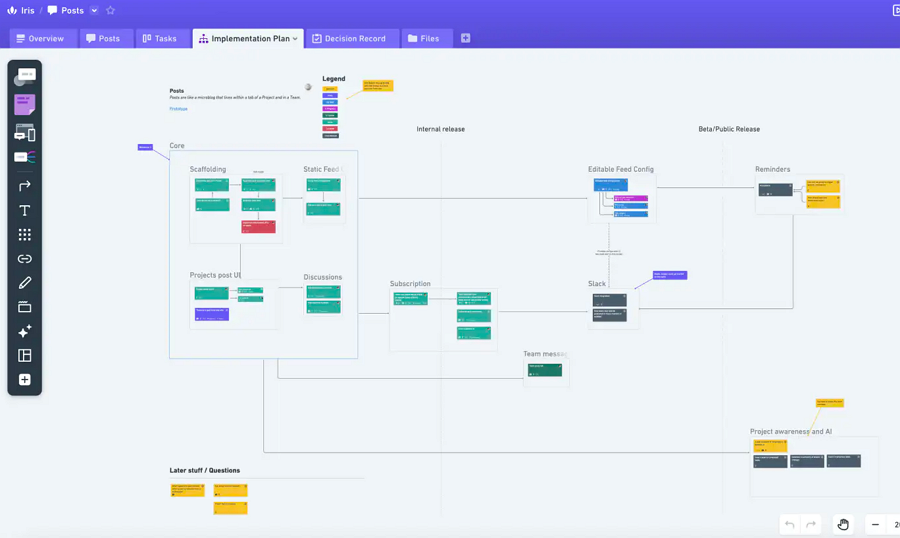
Whimsical is a fast, elegant visual collaboration tool combining whiteboarding, flowcharts, mind maps, and wireframes into one interface. It’s known for its clean design, keyboard-first controls, and real-time collaboration. Its smart shortcuts and ready-made components make it especially efficient for designers, PMs, and developers looking to visualize ideas quickly.
Best for those who value clarity, speed, and a polished user experience.
Key Features:
- Clean, drag-and-drop interface
- Multiple board types: whiteboards, flowcharts, mind maps, wireframes
- Keyboard shortcuts for quick editing
- Real-time multi-user collaboration
Pros:
- Very intuitive and visually polished
- Great for quick diagramming and wireframing
- Easy to learn with strong keyboard support
Cons:
- Limited integrations compared to bigger platforms
- Might lack advanced features for enterprise workflows
Pricing:
Free plan available; paid plans start at $10/month per user
Best For:
Product and design teams needing fast, visually clean whiteboarding and diagramming
5.Mural
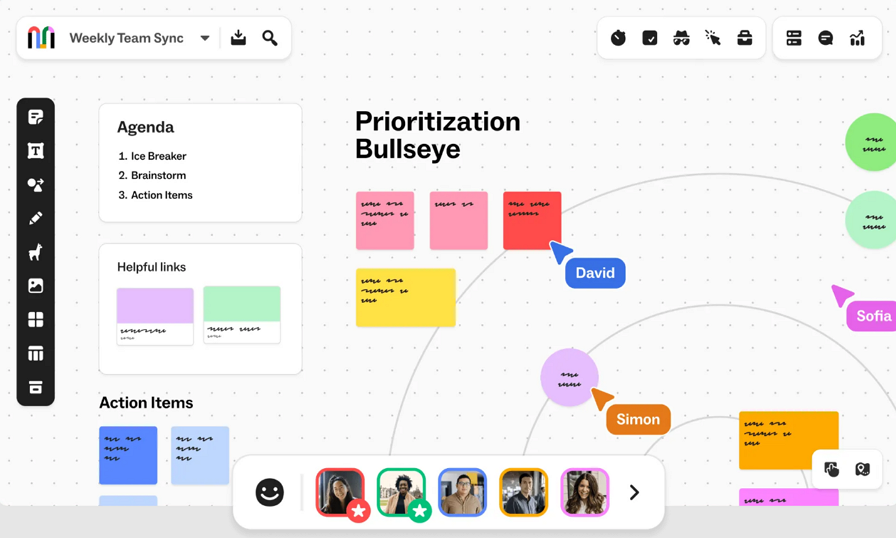
Mural is a digital whiteboard platform tailored for enterprise-level collaboration, workshops, and design thinking. It offers robust features like private mode, voting, and facilitation tools that make remote workshops feel structured and inclusive. Mural shines in strategic planning, retrospectives, and cross-functional ideation. It’s well-suited for organizations that need to guide sessions while capturing insights in real-time.
Key Features:
- Private mode and voting tools
- Facilitator controls and timers
- Extensive template library
- Integrations with Slack, Microsoft Teams, Jira, and more
Pros:
- Designed for professional workshops and meetings
- Strong facilitation and moderation features
- Large library of useful templates
Cons:
- Pricier than some alternatives
- Can be overwhelming for casual or small teams
Pricing:
Free trial available; paid plans start at $9.99/month per user
Best For:
Enterprise teams running workshops, retrospectives, or strategy sessions
6.Microsoft Whiteboard
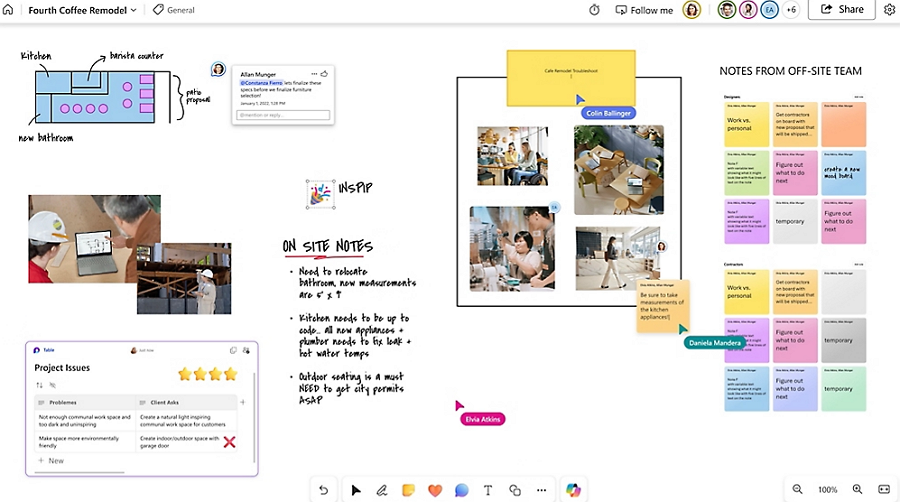
Microsoft Whiteboard is a simple, cloud-based digital canvas integrated deeply into the Microsoft 365 ecosystem. It supports freeform drawing, sticky notes, templates, and file sharing, making it easy for teams using Microsoft Teams, Outlook, or OneNote to collaborate visually.
While it’s more basic than some standalone tools, its seamless syncing and accessibility make it a convenient choice for organizations already invested in Microsoft’s productivity suite.
Key Features:
- Infinite canvas with drawing, text, and sticky notes
- Real-time collaboration within Microsoft Teams and OneNote
- Template gallery for common workflows
- Integration with Microsoft 365 apps
Pros:
- Free for Microsoft 365 users
- Smooth integration with popular Microsoft apps
- Easy to use for quick brainstorming
Cons:
- Lacks advanced features for complex workflows
- Limited third-party integrations
Pricing:
Free for Microsoft 365 subscribers
Best For:
Organizations and teams already using Microsoft 365 who want native whiteboarding
7.Jamboard

Google Jamboard was designed as a collaborative whiteboard app for Google Workspace users, offering basic drawing, sticky notes, and shape tools. While Google has announced the hardware and software are being phased out, the app remains accessible for simple collaborative brainstorming and note-taking.
It’s easy to use and integrates well with Google Drive but isn’t suitable for long-term or complex projects due to its limited features.
Key Features:
- Basic drawing and sticky notes
- Integration with Google Drive and Google Meet
- Simple multi-user collaboration
Pros:
- Free and easy to use
- Good for quick brainstorming sessions
- Tight integration with Google Workspace
Cons:
- Deprecated and no longer actively developed
- Lacks advanced features found in other tools
Pricing:
Free
Best For:
Google Workspace users needing lightweight, simple whiteboarding
8.Conceptboard

Conceptboard is a secure and flexible whiteboard designed for remote teams focused on visual project management and collaboration. It offers strong data privacy with GDPR compliance and on-premises hosting options for enterprises. The tool supports version history, detailed permissions, and embedding multimedia content, making it ideal for client presentations and structured workflows in industries like marketing and consulting.
Key Features:
- Secure, GDPR-compliant collaboration
- Version control and granular access permissions
- Multimedia embedding and commenting
- Integrations with Microsoft Teams and Slack
Pros:
- Enterprise-level security and compliance
- Strong collaboration features
- Good for client-facing presentations
Cons:
- Interface can feel dated
- Some learning curve for new users
Pricing:
Free trial available; paid plans start at €5/month per user
Best For:
Teams requiring secure collaboration with clients and strict data controls
9.Stormboard
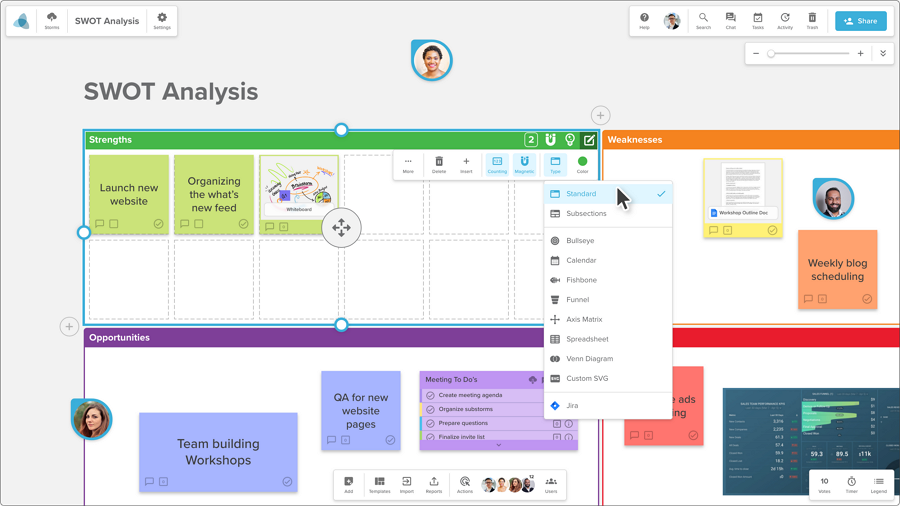
Stormboard offers a structured whiteboard experience combining sticky notes, templates, and visual frameworks to help teams brainstorm and plan effectively. It supports a variety of methodologies including SWOT analysis and Kanban boards, and automatically generates meeting reports to track action items. Its workflow-oriented design makes it suitable for teams focused on turning ideas into clear outcomes.
Key Features:
- Templates for meetings, planning, and retrospectives
- Real-time sticky notes and drawings
- Automated meeting summary reports
- Integration with Microsoft Teams and Slack
Pros:
- Structured sessions with productivity focus
- Automatic reporting features
- Easy to use with pre-built templates
Cons:
- UI feels less modern
- Limited integrations outside major platforms
Pricing:
Free plan available; paid plans start at $10/month per user
Best For:
Teams that want structured, outcome-driven whiteboard sessions
10.Milanote
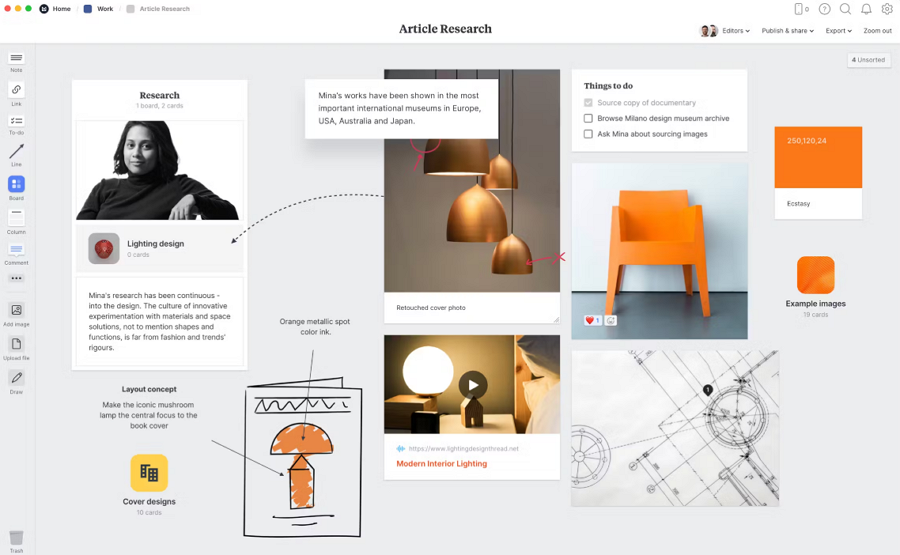
Milanote is a visual workspace designed for creative professionals to organize ideas, projects, and inspirations. It offers a flexible drag-and-drop canvas with notes, images, links, and task lists, making it great for mood boards, storyboarding, and project planning. Unlike traditional whiteboards, Milanote supports non-linear workflows ideal for designers, writers, and marketers who prefer a more freeform and visual approach to brainstorming.
Key Features:
- Drag-and-drop canvas with multimedia support
- Notes, images, and task boards
- Collaboration and commenting
- Project templates and mood boards
Pros:
- Excellent for visual storytelling and planning
- Intuitive and creative interface
- Great for early-stage brainstorming
Cons:
- Limited diagramming and flowchart features
- Not suited for complex workflows
Pricing:
Free plan available; paid plans start at $9.99/month
Best For:
Creative professionals planning visual and narrative-driven projects
11.ClickUp Whiteboards
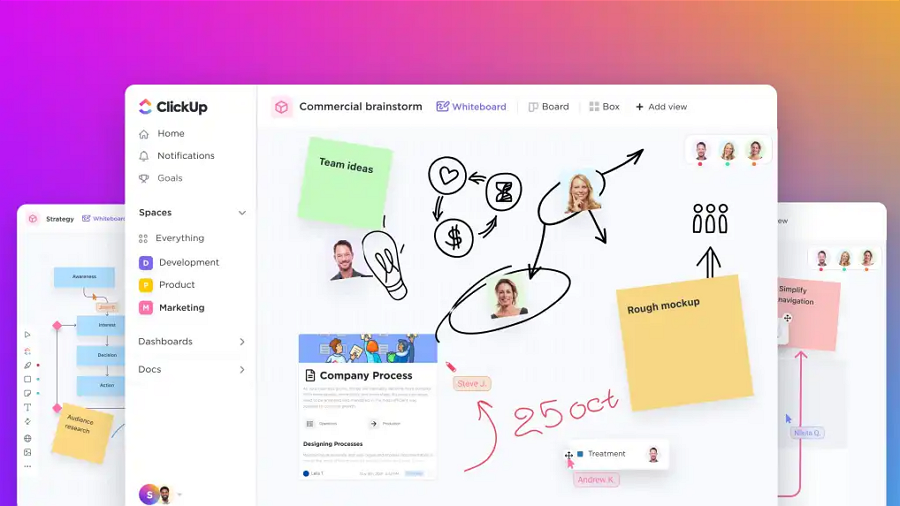
ClickUp Whiteboards combine freeform brainstorming with integrated task management to help teams move seamlessly from ideas to execution. Users can create drawings, sticky notes, and diagrams that link directly to ClickUp tasks, enabling better project tracking. Its integration with the broader ClickUp platform makes it particularly useful for teams wanting a unified workspace for collaboration and work management.
Key Features:
- Visual whiteboard with drawing and sticky notes
- Direct task creation from whiteboard elements
- Real-time collaboration and commenting
- Integration with ClickUp task management
Pros:
- Combines whiteboarding with project management
- Helps bridge planning and execution
- Strong collaboration tools
Cons:
- Less powerful as a standalone whiteboard
- Requires ClickUp usage for full benefits
Pricing:
Free plan available; paid plans start at $7/month per user
Best For:
Teams that want to combine whiteboarding with task and project management
12.Collaboard
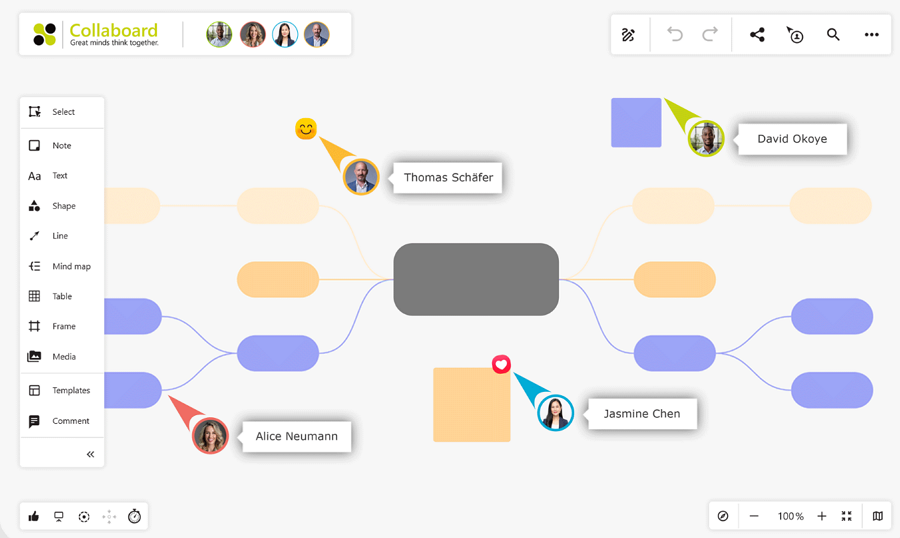
Collaboard is a visual collaboration whiteboard designed for secure, real-time teamwork across distributed teams. It’s known for its strong emphasis on data privacy, making it a preferred option for enterprises and government organizations.
With sticky notes, drawings, templates, and video conferencing all in one place, Collaboard allows teams to brainstorm, plan, and manage workshops with ease.
It’s a flexible tool suitable for remote ideation, education, and agile work.
Key Features:
- Secure, GDPR-compliant whiteboard collaboration
- Real-time co-editing with audio/video conferencing
- Ready-made templates for workshops, mind maps, and more
- Guest access without registration
Pros:
- High data privacy and security standards
- Supports cross-platform use on web, tablets, and interactive displays
- Great for formal workshops and enterprise environments
Cons:
- Slightly steeper learning curve
- UI feels less modern than some newer tools
Pricing:
Free plan available; premium plans start from €5/month
Best For:
Teams and organizations needing a secure and privacy-compliant whiteboard tool for remote collaboration
13.Limnu
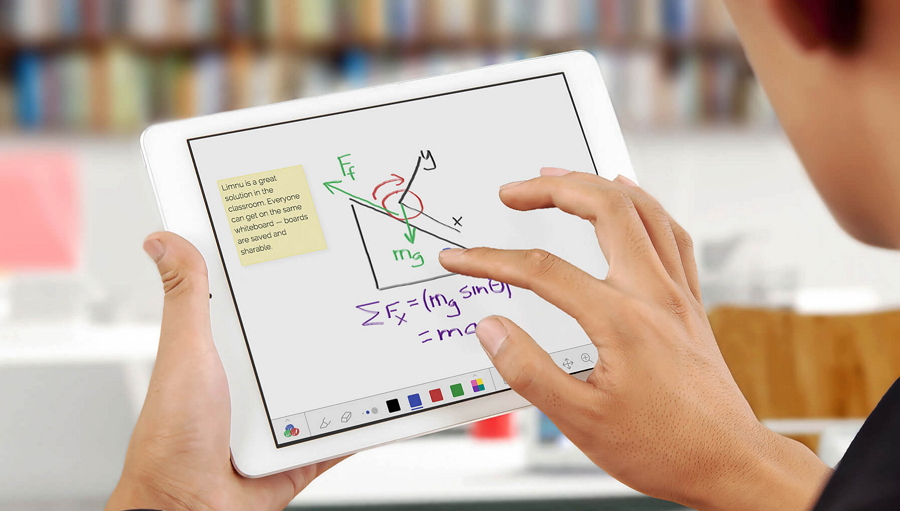
Limnu is a traditional-feeling online whiteboard that emphasizes simplicity, speed, and a realistic drawing experience. It’s ideal for teams who prefer a hand-drawn feel while working remotely on brainstorming sessions, planning, or teaching. Limnu is integrated with video conferencing, enabling seamless communication while sketching ideas together.
Key Features:
- Smooth, realistic whiteboarding experience
- Built-in video chat for team collaboration
- Fast drawing response even with remote participants
- Simple sharing and access control
Pros:
- Intuitive, marker-like interface
- Great for educators and design teams
- Minimal onboarding required
Cons:
- Lacks advanced diagramming features
- Not ideal for large-scale team or enterprise use
Pricing:
Free trial available; paid plans start at $5/month
Best For:
Small teams or educators wanting a realistic, marker-based digital whiteboard
14.Canva Whiteboards
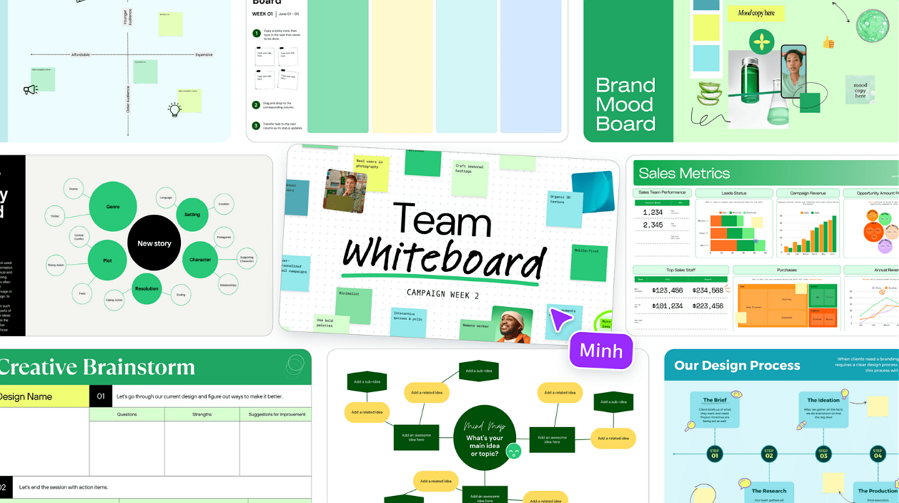
Canva Whiteboards provide an intuitive, design-focused canvas for team collaboration with infinite zoom, sticky notes, and a vast library of templates and assets. Built into Canva’s platform, it gives users access to millions of images, icons, and design elements to create visually rich whiteboards.
This makes it particularly attractive to marketing teams, educators, and creatives who want polished presentations alongside collaboration.
Key Features:
- Infinite canvas with sticky notes and drawings
- Extensive template and design asset library
- Real-time collaboration and commenting
- Integration with Canva’s design tools
Pros:
- Beautiful, easy-to-use interface
- Rich asset library for visual projects
- Great for marketing and education
Cons:
- Limited advanced diagramming tools
- Some features locked behind Canva Pro
Pricing:
Free plan available; Canva Pro at $12.99/month
Best For:
Visual thinkers, educators, and marketing teams needing polished whiteboards
15.Excalidraw
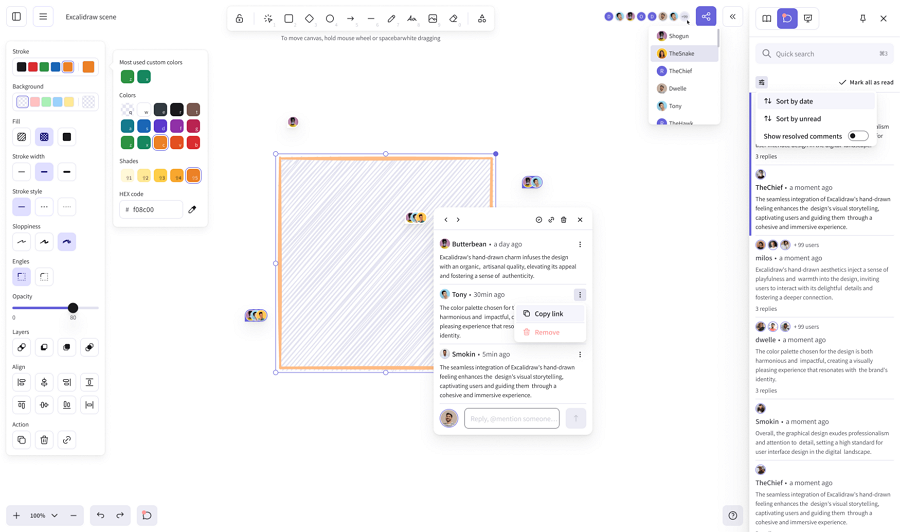
Excalidraw is a free, whiteboard that simulates hand-drawn sketches for quick, informal brainstorming and diagramming. It works entirely in the browser, supports offline use, and requires no account or installation. Its simplicity and privacy-focus have made it popular with developers, indie makers, and teams that want distraction-free, fast sketching without any bells and whistles.
Key Features:
- Hand-drawn style sketching and diagrams
- Offline and no sign-up required
- Real-time collaboration via shareable links
- Export to SVG, PNG
Pros:
- Ultra lightweight and privacy-friendly
- Great for fast sketches and rough ideas
- Free and open-source
Cons:
- Lacks templates and advanced features
- Not suited for detailed or structured diagrams
Pricing:
Free
Best For:
Developers and teams who want fast, simple, privacy-first sketching
Conclusion
Miro is a great tool, but it’s not the only one out there. Whether you want something faster, easier to use, more affordable, or packed with smarter features, there are many great whiteboard tools to choose from.
From powerful AI tools like Fluig to clean and simple options like Excalidraw, each alternative has its own strengths. No matter your team size or workflow, you can find a tool that fits how you work best.

